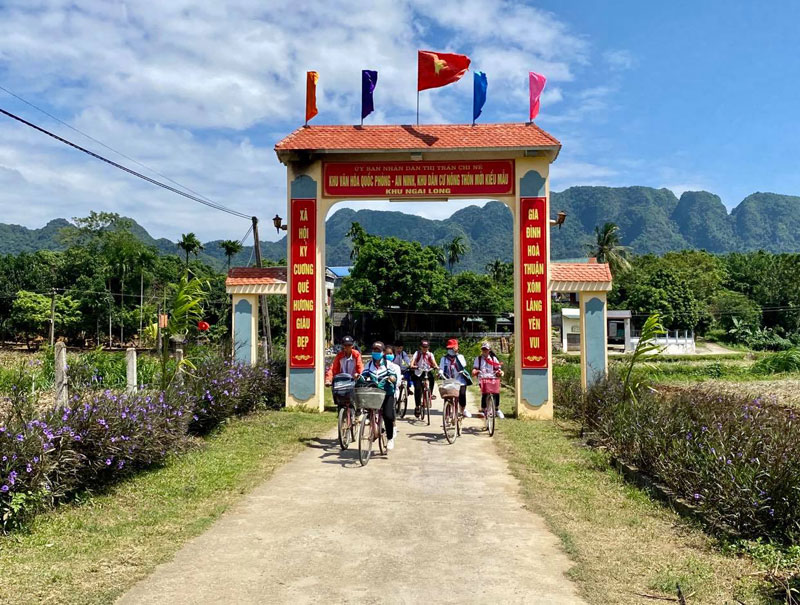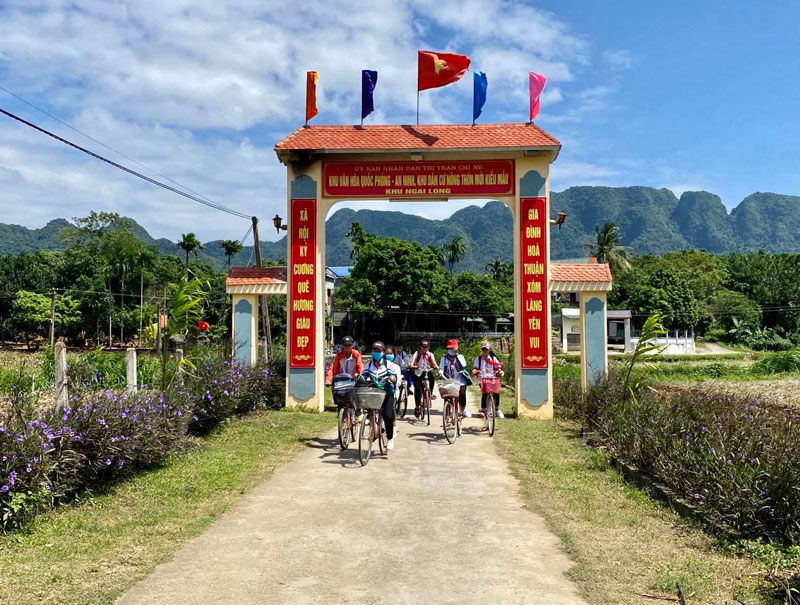
(HBO) – We were impressed with flowers along roads running through Ngai Long village in Chi Ne town, Lac Thuy district, Hoa Binh province.
 Flowers are grown along the road to Ngai
Long – a model new-style rural area in Chi Ne town, Lac Thuy district.
Flowers are grown along the road to Ngai
Long – a model new-style rural area in Chi Ne town, Lac Thuy district.
In
response to the new-style rural area building movement, local residents
contributed money and working days worth 500 million VND to building the
village’s gate, upgrading its cultural house, and growing flowers.
Their
efforts paid off as all of the roads in Ngai Long have been concretised and the
cultural house fully equipped to serve community activities.
Having
85 percent of the total households working in agriculture, the village has
stepped up the shift of plant and animal structures, and taken the lead in
replicating new models.
It
now counts five model orchards, including one covering 3,000 sq.m of Secretary
of the village’s Party unit Le Van Hoa who earns more than 120 million VND from
the trees.
Ngai
Long expects to raise its per capita income to 48 million VND this year, a rise
from 6 million VND in 2019. Thanks to efforts in the new-style rural area
building movement, the material and spiritual lives of locals have improved
significantly and the poverty reduction programme reaped significant outcomes.
The
village, therefore, has been regarded as an area worth living in Lac Thuy
district, with political security and social order and safety ensured./.
With an increasingly vibrant and widespread emulation movement aimed at building cultured residential areas and cultured families, Yen Thuy District has been making steady progress toward improving both the material and spiritual well-being of its people, while fostering a civilized, prosperous, beautiful, and progressive community.
Once lacking recreational spaces and community facilities, Residential Group 2 in Quynh Lam Ward (Hoa Binh City) has recently received attention for the construction of a new, spacious, and fully equipped cultural house. The project followed the model of state support combined with public contributions in both labor and funding.
The "All people unite to build cultural life" movement, which has been effectively integrated with Kim Boi district’s socio-economic development goals, is fostering a lively spirit of emulation across local residential areas, hamlets, villages, public agencies, and enterprises. In addition, through the initiative, traditional cultural values are being preserved and promoted, while community solidarity and mutual support in poverty reduction and economic development are being strengthened.
A working delegation of the Hoa Binh provincial People’s Committee led by its Permanent Vice Chairman Nguyen Van Toan on June 11 inspected the progress of a project to build the Mo Muong Cultural Heritage Conservation Space linked to tourism services in Hop Phong commune, Cao Phong district.
Born and growing in the heroic land of Muong Dong, Dinh Thi Kieu Dung, a resident in Bo town of Kim Boi district, in her childhood was nurtured by the sweet lullabies of her grandmother and mother. These melodies deeply imprinted on her soul, becoming an inseparable part of her love for her ethnic group's culture. For over 20 years, this love for her hometown has driven Dung to research, collect, and pass down the cultural values of the Muong people to future generations.
In the final days of May, the Ethnic Art Troupe of Hoa Binh Province organized performances to serve the people in remote, mountainous, and particularly disadvantaged areas within the province. These were not just ordinary artistic shows, but they were the meaningful journeys aimed at spreading cultural values, enhancing the spiritual life of the people and contributing to the preservation of ethnic minority cultural identities.



 Flowers are grown along the road to Ngai
Long – a model new-style rural area in Chi Ne town, Lac Thuy district.
Flowers are grown along the road to Ngai
Long – a model new-style rural area in Chi Ne town, Lac Thuy district.